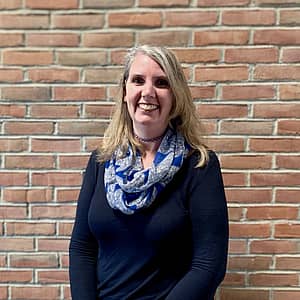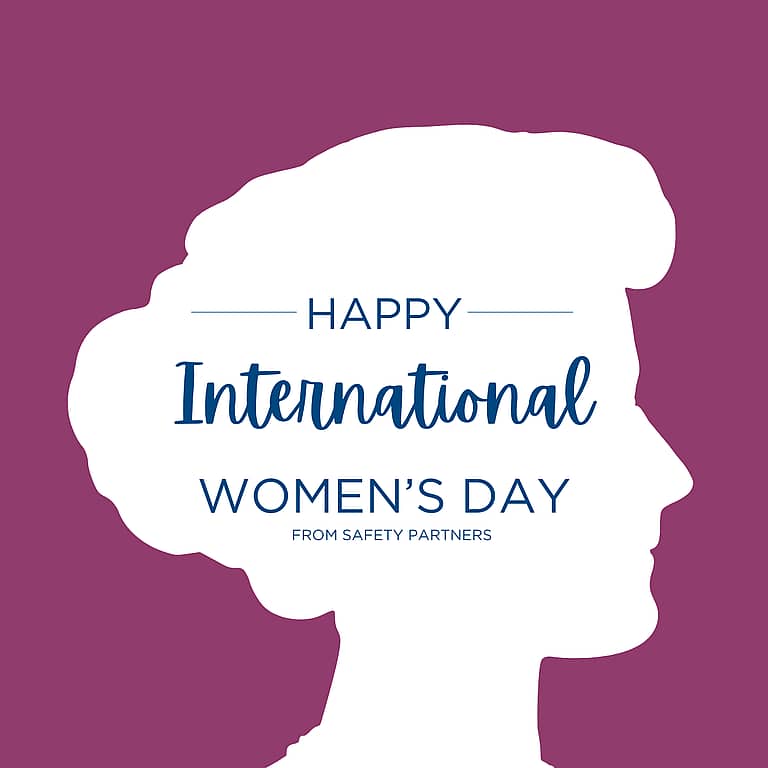In honor of International Women’s Day, we want to shine a light on Heather Houde, Senior Director EHS Client Services. Her career spans more than two decades at the at the intersection of science and safety. Let’s uncover the experiences, insights, and triumphs that define her unwavering commitment to fostering safety, collaboration, and innovation within the life sciences industry.
As we honor her achievements, we also recognize the countless women shaping the landscape of EHS, driving progress, and igniting change on this celebration of International Women’s Day.
Learn more about Heather and her path in this interview.

Q: Would you like to start by sharing a brief career overview?
A: Sure! I’ve been at Safety Partners for nearly 18 years now. I started my career after graduating from Colgate University with a bachelor’s degree in biology. I started out working at Dana-Farber Cancer Institute for about 5 years, and at the time my plan was to go to veterinary school. After 5 years at Dana-Farber, I got the opportunity to transition to a medical device company and work as a field operations specialist for a couple of years. Unfortunately, as we sometimes see in the biotech world, the company closed. I was then home raising a young family for about 3 years, and I came across the opportunity to work at Safety Partners and realized I could apply my lab experience to do something meaningful. At the time, I really had no idea EHS professionals existed, other than their involvement in the annual training we did at Dana-Farber, so it was a huge learning opportunity for me and a chance to use my background doing something new.
Q: What drew you to this field?
A: As EHS professionals, we play a crucial role in mitigating risk at our clients and ultimately protecting the employees. This field offers a wide range of responsibilities from conducting lab audits to doing training programs and getting involved with hazardous waste disposal as well as permitting. It provides a dynamic and engaging work environment, so every day is always something new.
Q: How have advances in science influenced your approach in life sciences and EHS?
A: Life sciences is a very fast-paced and ever-changing environment. There are new developments in research all the time and that information can be helpful in identifying risks that may not have been understood previously. The EHS field is a very collaborative one; everyone works together willingly, to share knowledge and make connections to help another person, and to try to prevent accidents or exposures from happening. As new information and new science is learned, you know that information will be shared in a collaborative environment and be used to help more people understand what the risk of a new technology they are working with may be.
Q: What is your favorite part about what you do?
A: I have a lot of things that I like about this role, including being able to get onsite at clients and really helping them understand their EHS responsibilities, and how we can put programs and policies in place to help keep their employees safe. Obviously, that’s important, but also I like just getting to work with different types of clients, different ranges of people at our clients as well as internally at Safety Partners. Working with such an amazing team at Safety Partners makes it a great place!
Q: Can you share a technological innovation that significantly improved outcomes in your field?
A: One advancement that we’ve seen over the years is the development of a safer lentivirus vector. Specifically, third or fourth-generation vectors that have been engineered to reduce the potential to generate a replication-competent lentivirus in cell culture are being used. This provides a greater margin of safety for the user. These later generation lentiviruses separate the vector and the packaging functions onto four or more plasmids and they’re also engineered so they don’t express a gene essential for replication of the HIV-1 wild type. So ultimately, using these later generation lentivirus vectors reduces the risk to the user of being infected should an inadvertent exposure occur in the lab. That’s just one example of how technology has made working in the lab a little bit safer.
Q: I know you’ve been at Safety Partners for a very long time, can you share your experience being in a leadership role?
A: I started as a Consulting Safety Officer at Safety Partners and moved into a Team Leader role and that was an opportunity to onboard and mentor new consultants. Five years ago I stepped into my current role as Director of EHS Client Services. I really enjoy being part of the management team and learning so much about the company’s operations. It has really highlighted an area that I didn’t know too much about when I started in the EHS field with my background as a biology major. I really enjoy being the conduit between the client services team and the management team and working to understand current challenges for our consulting staff in the field, as well as overseeing client and staff concerns and then providing solutions back to the management team.
Q: How do you foster an environment that encourages collaboration?
A: Being a good listener and being open to suggestions are so important. You can’t be too quick to just say no to new ideas but have to be willing to implement something new and sometimes take a risk. It’s important to really listen to your team and what’s happening at the clients as they are the ones that are onsite day-to-day dealing with challenges. I try to be open to their suggestions on how we can make things better, or maybe implement something new that we hadn’t thought about in the past.
Q: Are there any specific skills you’ve pursued to stay at the forefront of your industry?
A: A big thing with EHS which I don’t think a lot of people may think about is communication skills. It’s really very important in this role when you are going into a client and must communicate with the designated project manager about what you’re working on, the status of their program, etc. And even in my current role, communication is a huge part of that. We need to be able to listen, comprehend, and provide a clear solution, or at least a path forward. Being able to communicate that clearly, whether it’s with the client or with your own internal team, I think is really important.
Q: Reflecting on your 18 years of experience at Safety Partners, what would you consider the most significant challenge you faced and how did you overcome that?
A: I think in our role as consultants at Safety Partners, we oftentimes go into clients, and they just don’t have the budget or the resources to put a great safety program in place. We provide our suggestions, and when it comes down to it, they could have budget restrictions on what they’re able to do and the number of hours they are able to bring us in-house. There have been definite challenges over the years such as when I was directly supporting one client, they wanted 40-hour projects done in small pieces each requiring a project summary. Once they approved that, we moved on to the next project. So, it was a very small amount of EHS support that I was able to provide for that client. It took me two years to get their safety manual signed off! Progress just seemed slow as I was only there for infrequent 4-hour blocks of time. But then over time, as the company grew, I got integrated into the client. They had more resources, and we were able to grow their program and ultimately, I ended up being onsite at that client for two days every week. It can be really challenging to have to work with those clients knowing what they should do, what you want them to do, but then constantly pushing back that they don’t have the budget or the resources to do what we are recommending. But I feel if you are slow and steady it typically wins the race, right? Just chipping away and doing the best you can and understanding that they are trying to do the best they can with what they have, and we are just there to support them through that.
Q: Can you share a valuable lesson you’ve learned throughout your journey?
A: Not every client is going to follow our advice, and this can be extremely frustrating, but we need to continue to push to implement the best practices to keep our client employees safe. So, I think the lesson there is again, slow, and steady wins the race. We can do our best to provide that advice and guide them in the right direction. Ultimately, it’s their safety program and I think most people want to do the right thing. So, it’s typically a matter of time or in some cases, budget that allows them to move forward with the program that they really want.
Q: What emerging trends do you see shaping the future of EHS?
A: I’m seeing an enhanced employee engagement around safety and integration of the EHS program into the overall strategies at companies. We see that more and more employees are interested in their own safety and really pushing those initiatives up to the corporate level. There’s a growing emphasis on sustainability initiatives, things such as kitchen composting, recycling, energy conservation, etc. Sustainability is definitely an emerging trend we are seeing these days.
Q: For young women aspiring to be a scientist like you, what advice would you offer them based on your experience?
A: As I mentioned, I graduated college planning to go to veterinary school and that didn’t happen. What I’ve learned is that there are just so many opportunities in the life science industry for women. There is so much you can do in the life science field. You don’t have to have a solid path laid out, where you know what you want to do, but just go where your opportunities lead you. You never know you could end up in a role that you never knew existed like I did.
Q: What is next for you? Where do you want to continue to learn and grow?
A: It’s really been interesting working with the management team here at Safety Partners and learning more about the business and operations side of things. I was always science-focused and focused on learning. I’ve learned so much about the operations of a company. For me, continuing to learn more about managing a business to improve operations and continue to make Safety Partners a great place to work for all our employees is what I plan to do.


